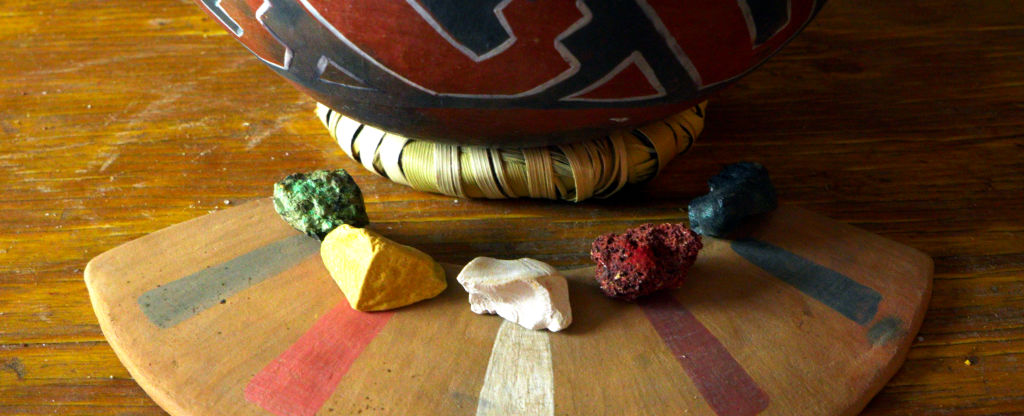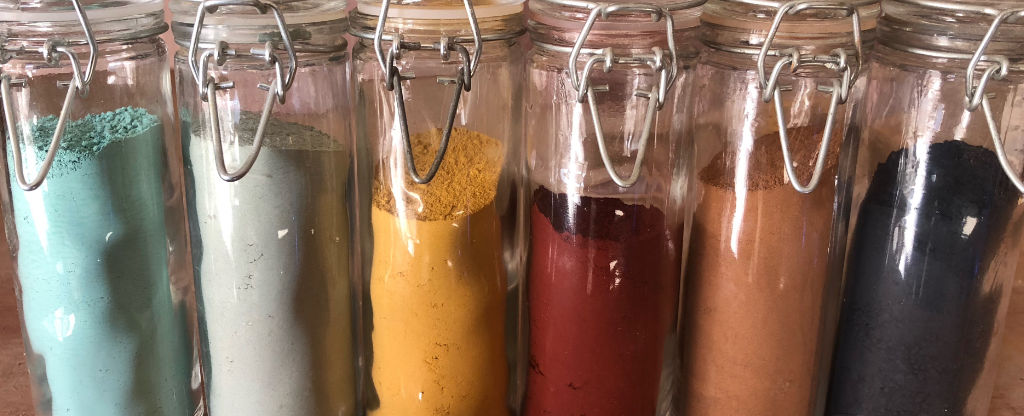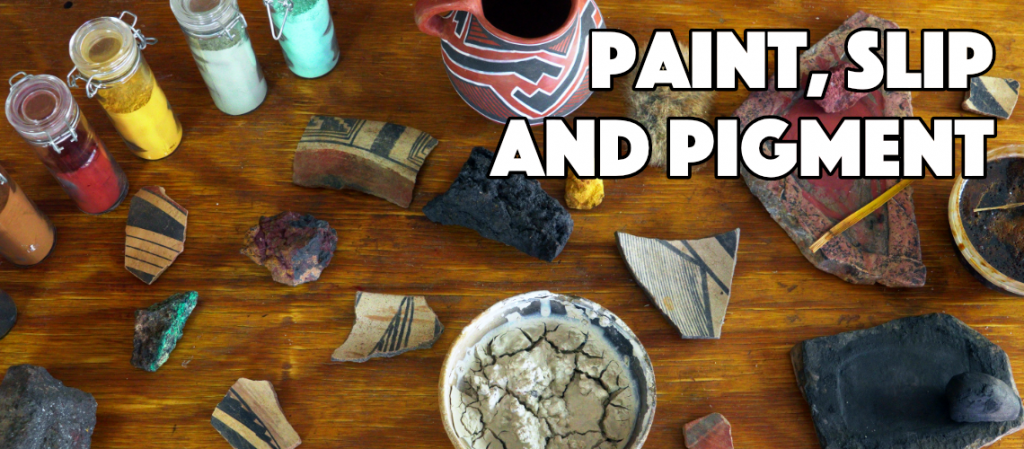Our ancestors decorated pottery with beautiful, rich colors that came directly from the earth. Yet today we rely on chemical colorants that come from a far-away factory. It is still possible to use earth pigments to produce stunning pottery in a range of earth colors. This online class teaches how to make and use colorful pottery paints and slips from natural minerals and plants. When you finish this class you will have the knowledge and skills to begin collecting natural earth pigments and making your own paints to decorate pottery in the way that the ancient potters of the American Southwest did centuries ago.
100% No Hassle Money-Back Guarantee
If within 14 days of purchase you don’t think this course is worth the money, just tell us and we will refund the full price, no questions asked, no problem!


Master new pottery skills with each lesson
Our lessons are set up in informative and easily understood segments which will allow you to master new techniques quickly.

Costs a fraction of an in-person pottery class or workshop
Most in-person classes cost hundreds of dollars but our video classes are just as educational and much more affordable.

Learn at a time and place convenient to you
Learn from home, while traveling, or anywhere else you have an internet connection and at any time of the day or night.

Watch videos of difficult techniques over again until you get it right
No more trying to remember what the instructor said or how they did a technique. Watch the video lessons over and over.

Personalized emails from the instructor will encourage you
You will receive encouraging emails from your instructor all through the class. Reply to these emails to get feedback and answers.

Learn the ancient art of pottery with convenient video lessons
If there is a better way to learn ancient pottery making techniques, we don’t know it. Learn from home in your underwear, does it get any easier than that?

Course Objectives
In this course you will learn how to make and use the most common types of natural pottery paints and slips that were use in the American Southwest prehistorically. When you are done with this class you should be able to identify common mineral pigments, and prepare slip, yucca brushes, mineral and organic paints yourself.
- Learn what slips are and what they are used for
- Become familiar with different ways to prepare and apply slips to pottery
- Identify different pigment minerals and learn what colors they will fire to.
- Learn the best ways to prepare minerals for use as paint
- Familiarize yourself with the best recipes for making mineral paint and the required ingredients
- Learn what organic pottery paint is and how it works
- See how organic paint is made and explore the finer points of its application
- Become familiar with yucca leaf paintbrushes and how to make them yourself
- Explore ancient examples of painted pottery and how the different colors and designs were achieved
Upon completion of the Natural Pottery Paints, Slips and Pigments class you will be able to find and process natural pigment minerals into pottery paint no matter where you live on earth.


Hi Andy
I have went back through the lessons and previous videos but am a little lost .
I If i am painting a pot red with black design (no white ) I would first slip the whole pot with red ochre slip then paint the hematite slip design on top of the red, is the pot dry at this time? For both the red and black?
If i want to paint a design or stripes onto a nature clay pot (no slip)will it stay on after the firing? And at what point of dryness of the pot would I paint those stripes onto the pot?
great course
thank you
tom kitchener
You are confusing me. You wouldn’t paint hematite paint onto a red ochre slip, that would result in red designs on a red pot. Slip goes on a leather hard pot, paint can go on at any time. Paint will stay on after firing if you have made it that way I show in the class, that is add clay and organic binder.
i am sorry i should have said manganese to make the black design on the red background.
To produce that effect i need to red ochre slip the whole pot and then make a manganese base paint for my design. The red slip goes on while the pot is leather hard and then the paint goes on anytime once it is dry?
I am making the mug that is in your challenge and , like you did, i want the whole thing red first.
i am sorry i am totally new to it and it just wouldn’t sink in.
thank you
tom kitchener
Oh yes, that makes a lot more sense. You don’t have to use red ochre, you could also use red clay, it’s just what you have available. If you are using ochre make sure that you burnish it all so it sticks to the pot, unless you already know that your ochre has some amount of clay in it.
Are you finding these items or ordering them on the internet? Because I’m not sure you can purchase red ochre.
For now I am going to have to order the minerals online from a pottery supply store here in Canada. I can’t do the searching for minerals until the spring. I am looking forward to getting at that, lots of areas to explore. Most of it bush but there are a lot of river valleys that have exposed the underlying formations.
Like you said it doesn’t look like i can get red ochre. I can get red iron oxide and i can get manganese dioxide. i am hoping these will work.
thank you
tom kitchener
I am levigating some clay to make the fine clay to mix with my paint and slip. The problem is my raw clay has tiny plant pieces mixed in and it was always floating to the top, i couldn’t get them to pore off. I levigated the heavy stuff from the raw clay numerous times, then ran the finest clay/water mix through the paint filter which solved that problem. i don’t know if there are finer filters available but the ones i have are 190 microns and removed all the floaty stuff.
Maybe helpful
tom kitchener
I should say that the paint filters i used were the cones shaped paper/screen type that autobody shops use when painting cars. they are finer than the general box or paint store ones. any automotive refinishing supplier will have them.
tom kitchener.
And even after that you had organic junk in your clay? Weird. I’ve never experienced that.
Have you tried paint strainer bags?
My clay source is under a bunch of vegetation and its hard to get deep enough to avoid it. Most of the big organic stuff just floats off but there is a lot of pesky stuff that just does not want to leave. That clay works so good for building but next summer i will do more exploring and see if i can find cleaner clay.
I haven’t tried the paint strainer bags but if they are fine enough they would be easier to use. I had the fine automotive ones at home so i used them. I will definitely pick some strainer bags up next time out.
thank you very much for your help
tom
Win some loose some. I was out and did a outdoor firing today. The loss is cracked pottery but i will eventually figure that part out.
The win and i’m very happy is the paint and slip. i used red iron oxide i bought from a pottery store and made a slip and paint with it. Both attached themselves to the pottery rock hard. the colours look good. I also made manganese dioxide paint from pigment that i also bought at the same pottery store, i only had a few small lines of this painted on one pot just to test but it also is hard and part of the pot now. The manganese dioxide paint isn’t really black but more of a dark grey. You showed how to make it work better. All in all a real good day.
thank you
tom kitchener
Sounds like you are making goods progress Tom, keep up the good work!
Hello,
I wonder how do you polish the pots? I´ve done that with a stone or piece of plastic but then there was no paint. Do you use some oil or wax after firing?
I polish slipped areas before the painting, but I don’t generally polish the paint or painted areas. And no I do not use any wax or oil after firing unless I am trying to seal the pottery.
Hi Andy, I enjoyed this class. I am still a little confused about the manganese paint recipe. I think you said 40% copper sulphate, 40% manganese and 20%salt and just a bit of mesquite crystals.? And in another video I think you said you wouldn’t drink out of a mug because it had manganese black paint
around the rim and that was toxic? Maybe I should use organic black paint in mugs or pots I want to use, even if manganese paint was more traditional. Or what do you suggest. Thanks, Martha P.S. It seems like you have to buy an awful lot of copper sulphate when you only need a little bit…..
It’s copper carbonate I use, I don’t know anything about copper sulphate. The recipe given in this class did not include any salt, it was 20% clay. Manganese dioxide is toxic, don’t breathe or ingest it. Organic paint is completely safe but it much more difficult to get right, requiring just the right slip and firing atmosphere and temperature.
Andy,
I like the detailed explanations of finding, preparing and using the minerals & organic paints. I could really use some demos and information on the actual application, perhaps a video on the process of planning a design, carrying it out etc.
I’d also like some info on choosing designs? Do you study individual ancient pots to determine what you’ll do or do you come up with designs that are an amalgamation of different designs? Do you keep examples around for inspiration?
When is the right time to slip? Can you slip multiple times? When to burnish – like how long should it dry. (I tried burnishing a yellow clay and must’ve been too soon all I did was rub off/mess up the slip.
Do I burnish after adding more color? If I’m doing say a red pot (slipped) with black & white details would I slip the entire pot red, let that dry and paint over the black and white designs?
Or do I need to put each color on independently (no overlap.)
Being a beginner at handling clay, drying pots etc. it would really be awesome to walk through some of that here in addition to the slip, mineral & organic prep you’ve provided- which is awesome!
Hi Andy,
I followed your formula from this lesson for mineral black paint, 40% manganese, 40% copper and 20% clay (+binder) and found it to be fugitive after firing. I noticed on your live stream this weekend and in your YouTube video that you appear to be saying 30% clay now. Should I up the % of clay in my black paint?
All the best, Richard
Yes. While the 40-40-20 recipe was working for me, several of my students were having trouble with fugitive paints so I started recommending 33-33-33 and that seems to solve the problem for most people. Also make sure the clay you are using in the paint is purified and levigated, the finer the particles the better it is going to work in the paint.